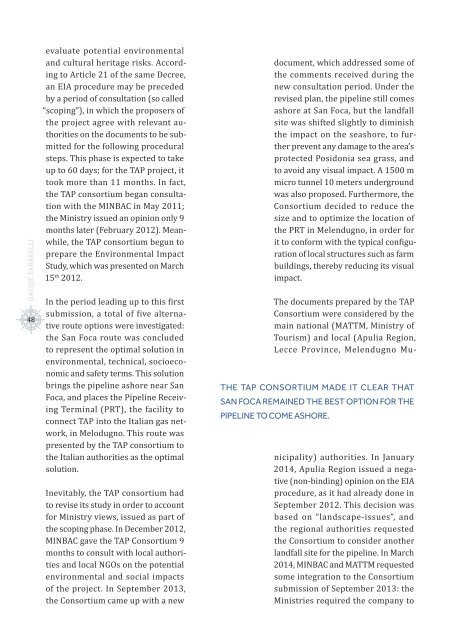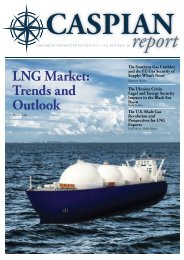Caspian Report - Issue: 07 - Spring 2014
You also want an ePaper? Increase the reach of your titles
YUMPU automatically turns print PDFs into web optimized ePapers that Google loves.
Davide Tabarelli<br />
48<br />
evaluate potential environmental<br />
and cultural heritage risks. According<br />
to Article 21 of the same Decree,<br />
an EIA procedure may be preceded<br />
by a period of consultation (so called<br />
“scoping”), in which the proposers of<br />
the project agree with relevant authorities<br />
on the documents to be submitted<br />
for the following procedural<br />
steps. This phase is expected to take<br />
up to 60 days; for the TAP project, it<br />
took more than 11 months. In fact,<br />
the TAP consortium began consultation<br />
with the MINBAC in May 2011;<br />
the Ministry issued an opinion only 9<br />
months later (February 2012). Meanwhile,<br />
the TAP consortium begun to<br />
prepare the Environmental Impact<br />
Study, which was presented on March<br />
15 th 2012.<br />
In the period leading up to this first<br />
submission, a total of five alternative<br />
route options were investigated:<br />
the San Foca route was concluded<br />
to represent the optimal solution in<br />
environmental, technical, socioeconomic<br />
and safety terms. This solution<br />
brings the pipeline ashore near San<br />
Foca, and places the Pipeline Receiving<br />
Terminal (PRT), the facility to<br />
connect TAP into the Italian gas network,<br />
in Melodugno. This route was<br />
presented by the TAP consortium to<br />
the Italian authorities as the optimal<br />
solution.<br />
Inevitably, the TAP consortium had<br />
to revise its study in order to account<br />
for Ministry views, issued as part of<br />
the scoping phase. In December 2012,<br />
MINBAC gave the TAP Consortium 9<br />
months to consult with local authorities<br />
and local NGOs on the potential<br />
environmental and social impacts<br />
of the project. In September 2013,<br />
the Consortium came up with a new<br />
document, which addressed some of<br />
the comments received during the<br />
new consultation period. Under the<br />
revised plan, the pipeline still comes<br />
ashore at San Foca, but the landfall<br />
site was shifted slightly to diminish<br />
the impact on the seashore, to further<br />
prevent any damage to the area’s<br />
protected Posidonia sea grass, and<br />
to avoid any visual impact. A 1500 m<br />
micro tunnel 10 meters underground<br />
was also proposed. Furthermore, the<br />
Consortium decided to reduce the<br />
size and to optimize the location of<br />
the PRT in Melendugno, in order for<br />
it to conform with the typical configuration<br />
of local structures such as farm<br />
buildings, thereby reducing its visual<br />
impact.<br />
the TAP consortium made it clear that<br />
San Foca remained the best option for the<br />
pipeline to come ashore.<br />
The documents prepared by the TAP<br />
Consortium were considered by the<br />
main national (MATTM, Ministry of<br />
Tourism) and local (Apulia Region,<br />
Lecce Province, Melendugno Municipality)<br />
authorities. In January<br />
<strong>2014</strong>, Apulia Region issued a negative<br />
(non-binding) opinion on the EIA<br />
procedure, as it had already done in<br />
September 2012. This decision was<br />
based on “landscape-issues”, and<br />
the regional authorities requested<br />
the Consortium to consider another<br />
landfall site for the pipeline. In March<br />
<strong>2014</strong>, MINBAC and MATTM requested<br />
some integration to the Consortium<br />
submission of September 2013: the<br />
Ministries required the company to










